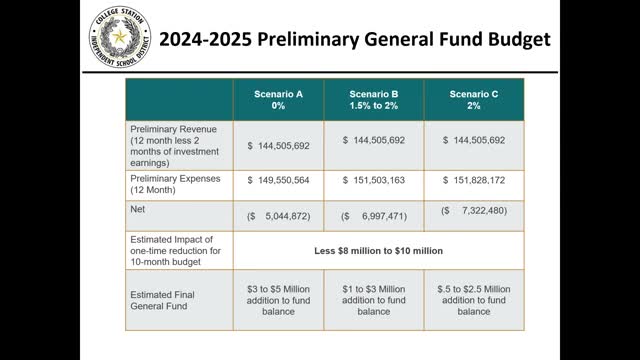School budget crisis deepens amid rising inflation challenges
June 20, 2024 | COLLEGE STATION ISD, School Districts, Texas

This article was created by AI summarizing key points discussed. AI makes mistakes, so for full details and context, please refer to the video of the full meeting. Please report any errors so we can fix them. Report an error »

In a recent government meeting, officials discussed significant budgetary challenges facing the education sector, highlighting a reduction of approximately $3.6 million in operational expenses. The focus for the upcoming year will be on scrutinizing spending practices, with an emphasis on achieving further cost savings. However, concerns were raised about the sustainability of these cuts, particularly given that 85% of expenditures are personnel-related.
Participants expressed frustration over the lack of new revenue streams to support necessary pay raises for teachers amidst rising inflation. The current funding structure, which ties revenue to student enrollment rather than property values, has created a situation where increased property values do not translate into additional funding for schools. This has led to what some described as a \"structural insolvency,\" placing undue financial strain on educational institutions.
The discussion also touched on the impact of inflation on per-student funding, with estimates indicating that the real value of funding has decreased significantly since 2019. This decline translates to a loss of approximately $30,000 per elementary classroom, exacerbating the financial difficulties faced by schools.
Despite slight improvements in attendance rates, officials acknowledged the need to focus on enhancing these figures to secure additional revenue. The meeting underscored the urgent need for a reevaluation of the funding system to ensure that schools can adequately support their staff and maintain quality education for students.
Participants expressed frustration over the lack of new revenue streams to support necessary pay raises for teachers amidst rising inflation. The current funding structure, which ties revenue to student enrollment rather than property values, has created a situation where increased property values do not translate into additional funding for schools. This has led to what some described as a \"structural insolvency,\" placing undue financial strain on educational institutions.
The discussion also touched on the impact of inflation on per-student funding, with estimates indicating that the real value of funding has decreased significantly since 2019. This decline translates to a loss of approximately $30,000 per elementary classroom, exacerbating the financial difficulties faced by schools.
Despite slight improvements in attendance rates, officials acknowledged the need to focus on enhancing these figures to secure additional revenue. The meeting underscored the urgent need for a reevaluation of the funding system to ensure that schools can adequately support their staff and maintain quality education for students.
View full meeting
This article is based on a recent meeting—watch the full video and explore the complete transcript for deeper insights into the discussion.
View full meeting
